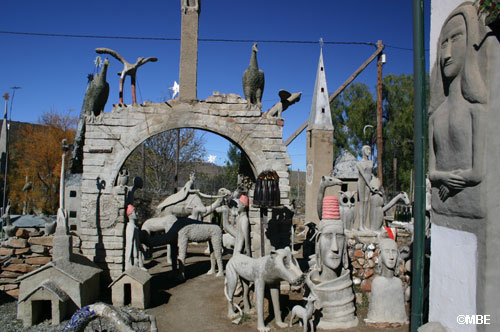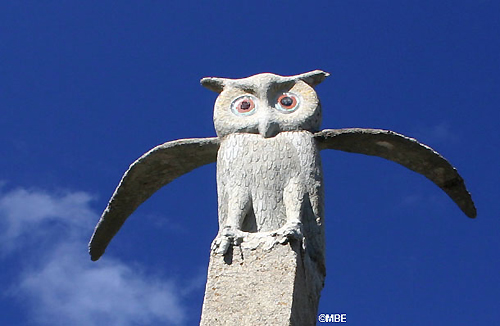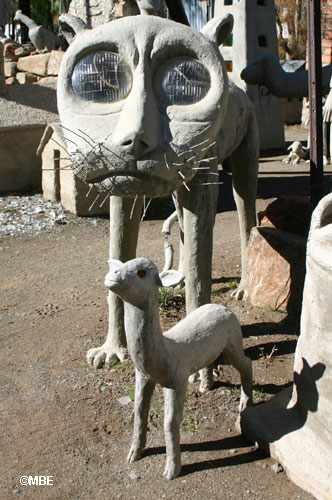skip to main |
skip to sidebar

Cerussite 'Honeycomb'

Cerussite (red) with Bayldonite and Calcite

Smithsonite with Hydrocerussite

Calcite with Cuprite inclusions

Malachite on Dolomite

Azurite on Cerussite

Cuprite on CopperThe Tsumeb Mine is arguably the finest mineral locality ever discovered. The ore-body produced a diverse range of specimens and spectacular crystals which were, and still are, sought after world-wide.
This website says of the Tsumeb orebody:"Tsumeb offers one of the greatest varieties of mineral assemblages known. It produced 247 known species, plus 24 species still under investigation.
Of the minerals discovered in Tsumeb, 45 are known to occur solely there. But not only the rare finds boast of superlatives. The crystallization of most minerals is so perfect and aesthetic that 68 species from Tsumeb display the finest crystals known from any deposit.
Many localities have produced specimens generally considered to be the finest of the species ever found. However, most of the localities are known only for one or two species of this quality.
In comparison, Tsumeb exhibits more outstanding mineral specimens than most localities even contain minerals. These minerals provide the quality benchmark for every collector."
As I explained in an earlier post, I worked as a miner for 12 years at the Tsumeb Mine and during that time I was privileged to see many examples of these spectacular crystals.
I've stood in vugs surrounded by crystals, jewels glittering in my headlamp. I've seen men shiver with greed, fight over and risk their lives to get them - 'crystal fever' - and in truth, I was also overwhelmed on occasion, though not to the extreme I've just described.
The removal of mineral specimens was always a murky and controversial issue. Although it was considered theft and people could be fired if caught, everyone from laborers to managers carried them out.
There was a constant stream of European and American buyers in town, offering big bucks for top pieces.
The official policy was that the purpose of the mine was to mine ore, not preserve mineral specimens but, if found, miners were 'expected' to save and hand them over to the 'Company', so that they could be sold on auction - with no reward to the finder.
This presented a problem to those who also appreciated the specimens for their aesthetic value - it was unthinkable to just leave these unique crystals to be dumped into an ore-pass, to be destroyed in the crushers.
On the other hand, if they were handed over to the company, the best pieces would be skimmed off by greedy hands long before they reached any auction.
Today, twelve years years after the closure of the Tsumeb mine, the saddest aspect is that there are very few spectacular specimens in Namibia itself - most are to be found in private collections and museums overseas.
The first image is from the Sussman Collection and the rest from the John Schneider Collection - more specimens via Arkenstone Fine Minerals
All photos in this post by John Schneider..
 From About.com:
From About.com:
Helen Elizabeth Martins ('Miss Helen') is considered South Africa's foremost Outsider Artist.
(Outsider Art was first recognized by the French artist Jean Dubuffet, who coined the term 'Art Brut', or Raw Art, and described it as "fantastic, raw, visionary art created by individuals often maladjusted, with no art training, who work outside the mainstream of the art world.")
 ... left with few prospects in a marginalized Karoo village, Martins became increasingly reclusive and isolated from the local community.
... left with few prospects in a marginalized Karoo village, Martins became increasingly reclusive and isolated from the local community.
Known to the residents as 'Miss Helen' and thought of as a strange and rather outlandish character, she shied away from general contact, and began transforming her house and garden ... ... Helen Martins' art was greeted with derision and suspicion from the village.
... Helen Martins' art was greeted with derision and suspicion from the village.
Despite crippling arthritis, and the amputation of her small toes (her feet were disfigured from wearing narrow shoes) which left her unable to wear anything but slip-ons on her feet, Martins decorated her home with 'glass and light' ...
 ... In 1964 Helen Martins employed Koos Malgas, an itinerant sheepshearer, to help her make the cement-and -glass statues which fill the Camel Yard outside her house. Formally the garden, this sculpture yard had over 300 figures and animals.
... In 1964 Helen Martins employed Koos Malgas, an itinerant sheepshearer, to help her make the cement-and -glass statues which fill the Camel Yard outside her house. Formally the garden, this sculpture yard had over 300 figures and animals.
Malgas became her foremost friend and companion, and remained by her side for the last 12 years of her life. Helen's close relationship with her Coloured assistant was viewed with great suspicion by Nieu Bethesda's Apartheid era residents ... ... Helen Martins' eyesight began to fail and in 1976 she took her own life by swallowing a mixture of caustic soda and crushed glass in olive oil.
... Helen Martins' eyesight began to fail and in 1976 she took her own life by swallowing a mixture of caustic soda and crushed glass in olive oil.
She could not bear the thought of going blind - a great theme in her life and work is light - and she was worried that she would be taken away from her life's work. Koos Malgas remained for another two years before relocating to Worcester, but returned in 1991 to assist in the restoration of the Owl House which had been declared a national monument and was supported by the newly created Owl House Foundation.
Koos Malgas remained for another two years before relocating to Worcester, but returned in 1991 to assist in the restoration of the Owl House which had been declared a national monument and was supported by the newly created Owl House Foundation.
It had been Helen Martins' greatest wish that the Owl House and Camel Yard be preserved as a museum. I would love to make a pilgrimage to Miss Helen's Owl House someday - I feel like we share a similar twist of mind ...
I would love to make a pilgrimage to Miss Helen's Owl House someday - I feel like we share a similar twist of mind ...
More info and images here and here.
Images in this post by Marion Boddy-Evans
.
In all the years I've visited the Etosha Pans I've never been able to get up-the-nostrils close to any of the big Cats - this last visit was no different but, I did encounter Lion at a distance on two occasions:.JPG) The first time we came upon a pride eating their previous-night's kill, they were about 150 meters from the road and it was difficult to get any good shots.
The first time we came upon a pride eating their previous-night's kill, they were about 150 meters from the road and it was difficult to get any good shots..jpg) They were finishing-off the remains of some hapless beast. It was impossible to see what kind of animal their prey was but someone told me that it was a Zebra.
They were finishing-off the remains of some hapless beast. It was impossible to see what kind of animal their prey was but someone told me that it was a Zebra..JPG) There were about 30 to 40 Jackals gathered on the outskirts of the feast, hoping for some scraps. Here one of the male Lions chases some of them off after they ventured too close.
There were about 30 to 40 Jackals gathered on the outskirts of the feast, hoping for some scraps. Here one of the male Lions chases some of them off after they ventured too close..JPG) The next day we spotted this male sleeping under a bush about 50 meters from the road - I got the mental impression of a fat golden sausage lying in the shade.
The next day we spotted this male sleeping under a bush about 50 meters from the road - I got the mental impression of a fat golden sausage lying in the shade..JPG) He was obviously feeling satiated from the previous day's kill and we had to wait about half-an-hour before he even blinked an eyelid.
He was obviously feeling satiated from the previous day's kill and we had to wait about half-an-hour before he even blinked an eyelid..JPG) He probably wanted to get rid of us curious humans so he posed for a few shots - nice gnashers hey?
He probably wanted to get rid of us curious humans so he posed for a few shots - nice gnashers hey?.JPG) Finally, he became bored and with a great big yawn he lay down and went to sleep again.A LION TALEI'll probably be in trouble for telling this story but, it involves lions so here goes:
Finally, he became bored and with a great big yawn he lay down and went to sleep again.A LION TALEI'll probably be in trouble for telling this story but, it involves lions so here goes:
A few years ago my daughters and I were in Etosha when we spotted two lions lying under a tree about 50 meters off the road, like the fellow in the pics above.
We stopped to observe them and within minutes were surrounded by about five carloads of tourists all jockeying for a good viewing position.
Everyone had their windows open, hoping that the lazy animals snoozing in the shade would do something so that they could take photos.
It was steaming hot and uncomfortable but, this was the vibe, the ambiance of Africa - stifling heat, dust, sweat and, best of all, lions in their natural environment. Everyone was entranced, quiet, the air thick with expectation.
We were in a double-cab pickup, my daughters in front and me on the backseat. It was obvious to me that the lions weren't going to provide any show. I was becoming bored so I dreamily reclined on the seat, bare feet sticking out the window.
After awhile, in a near-stupor, I felt the need to break-wind. Unfortunately, what I thought would be a little 'sneaker' turned out to be a thunderclap which destroyed the pristine silence.
Well, except for a muted snigger from one of the cars, there was once again complete silence after my lion impersonation but, the damage had been done, the ambiance shattered.
The girls turned around and glared at me as they tried to become invisible in their seats.
Nadine started the car and we slunk away. Being the coward that I am, I continued lying out of sight on the back seat and let them take the heat of embarrassment.
Needless to say, I was in the dog-box for the rest of the day.
So, on the off-chance that a visitor who was there that day reads this, I'd like to apologize for ruining your African Experience.
Related Posts:
Etosha National Park - A Timeless Experience
Etosha - Elephants
.







.JPG)
.JPG)
.jpg)
_008%20(Large).JPG)
.JPG)
.jpg)
.JPG)
.JPG)




.JPG)
.JPG)
.JPG)
.JPG)
.JPG)
.JPG)
.JPG)
.JPG)
.JPG)
.JPG)
.JPG)
.JPG)












.JPG)
.jpg)
.JPG)
.JPG)
.JPG)
.JPG)
.JPG)